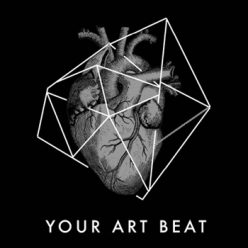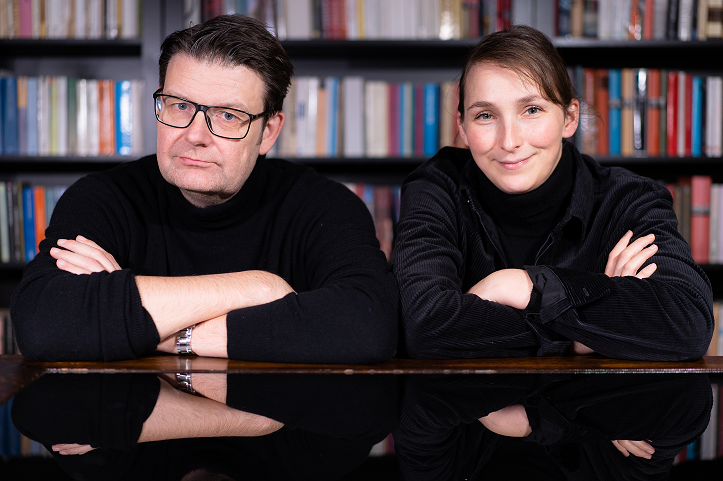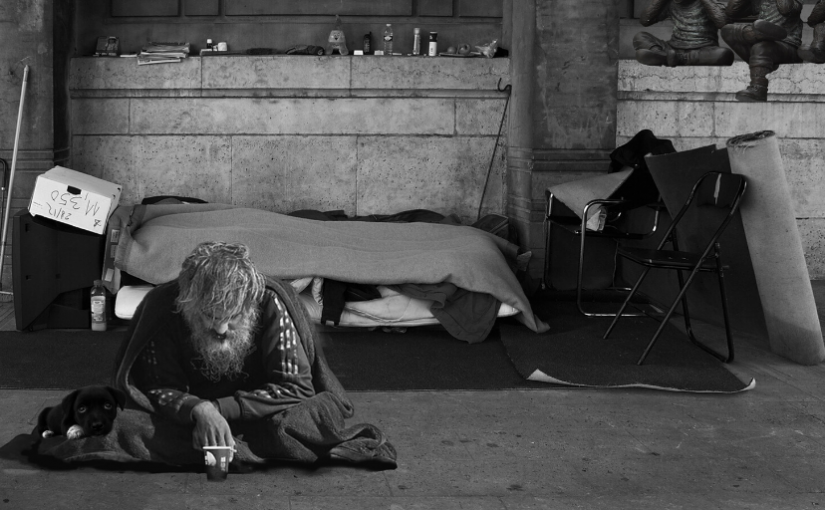The term Strollology translates as walking science and stems from the English term “to stroll” = to go for a walk). Together with his wife Anna, Lars Roth founded the design studio Strollology in 2014. In addition to commercial projects, the agency is also focused on artistic projects and theoretical aspects of design. “If you’re working only in the commercial field, you can easily feel like a hamster in a wheel. It’s good for creative work to constantly expand one’s own horizon,” says Lars Roth.
In August 2020, they were part of the Karl-Marx-Allee Artwalk in Berlin together with YOUR ART BEAT. There, they presented their project “KMA Faces”. Anna and Lars photographed residents of Karl-Marx-Allee and morphed their faces with the help of a machine learning model. This was done by a Generative Adversarial Network (an artificial neuronal network) that constantly generated new variants of the KMA residents from the portraits – a work of art that will probably exist only once. “There is actually nothing that doesn’t already exist,” says Lars Roth.
Thanks to artificial intelligence, however, this might change. How? Read the full interview and learn more about Strollology.
Who is behind Strollology?
My wife Anna and I are behind it. We both studied visual communication at Kunsthochschule Kassel. The Swiss sociologist and design theorist Lucius Burckhard, who invented Strollology, taught in Kassel. I’ve always found his work exciting. I’m all into conscious perception. And Burckhardt initiated walks with the aim of sharpening participants’ awareness for their environment and adopting new perspectives. Of course, that has a lot to do with vision. In our walks through Berlin we took up the idea of Burckhardt’s thoughts and carried them on. In our blog www.strollology.com we tackled the topic in theory. In addition, we cooperated with various partners, such as Slow Travel Berlin and the B_Tours Festival, who deal with walking as an artistic practice.
Beyond that, Strollology is about conscious perception of the environment – a constant analysis and reflection of what surrounds us. There are two things that have always interested us: people and places. And I believe that places have their own aura, that is, they convey a special feeling. We often walked through Neukölln. Neukölln is an old working-class district that has changed radically several times in the course of the last century. Our intention with these walks and with Strollology in general was to create an awareness of that among the visitors. To make people aware of the things that surround them every day.
Lucius Burckhardt’s design-theoretical reflections, however, go far beyond the actual “walk”; it is much more about constantly questioning one’s own point of view – according to the saying “think outside the box”. This attitude has also increasingly been integrated into our practical work as designers. The combination of applied projects and theoretical analysis, that is what characterises Strollology for us. For example, we are very interested in artificial intelligence. We deal with this in the commercial field on the one hand and in free artistic projects on the other one.
So one could say that you are exploring the business world in order to create something new artistically?
If you look at it philosophically, then I would answer that question with yes. Strollology is first and foremost the philosophy behind our work. We humans are practically filters. We perceive all day long, for example when we walk through the city or move through the net. Our input therefore also influences our output. In our commercial projects, we try to insert our artistic input and our theoretical background. In our everyday life, in the commercial field, a lot of our work is hands on, of course. A large part of our agency’s daily routine is determined by implementing specific projects according to our clients’ wishes. But behind that is always our philosophy – mirroring what we do in the commercial sector, for example, – to rethinking it artistically, and vice versa.
You mentioned that you offered walks at the time in order to consciously perceive the surroundings. How can one imagine that? How did you guide the visitors?
We confronted participants with their own perception: What do I perceive? If I perceive something, what can I do with it? One tour, for example, was about the perception of Kottbusser Damm. The tour followed the course of a typical 18th century Sunday walk: through Cottbusser Thor out of the city on a sandy avenue to the spacious meadows of Hasenheide. This narrative corresponds to what we archetypically understand by a picturesque landscape and would call “beautiful”. Nowadays, the city has spread far beyond the former city limits, and the former rural character of Kottbusser Damm has given way to a noisy, 6-lane road. The tour was as much about creating a sense for the historical dimension of the place in the participants as it was about questioning what we consider beautiful and why.
The interview was conducted by Carsten Jan Weichelt


